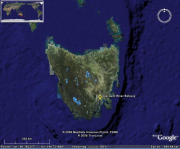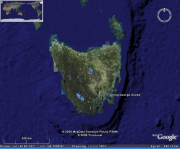25 154001
Type of resources
Topics
Keywords
Contact for the resource
Provided by
Years
-
This study assessed the spatial and temporal (horizontal and vertical) distribution of Asterias amurensis larvae in the Derwent Estuary and adjacent Storm Bay, SE Tasmania. Horizontal transport and development was assessed by collecting plankton samples at 2 or 4 week intervals, from July to December 2001, at 4 sites in the Derwent Estuary and 6 sites in Storm Bay. The effects of light and salinity on vertical distribution of larvae was examined over a 24 hour tidal and diel cycle.
-

This study reports on previously undescribed predation on Asterias amurensis in the Derwent Estuary, Tasmania by the spider crab Leptomithrax gaimardii (Milne Edwards). Specifically, this study describes the predatory interaction between the spider crab and A. amurensis and quantifies patterns of sub-lethal injuries inflicted on the seastar during a localised aggregation of the spider crab.
-

This study compared the individual and combined effects of two introduced marine species in SE Tasmania - the northern Pacific seastar (Asterias amurensis) and the European green crab (Carcinus maenas) - and investigated their impact on native invertebrate fauna using in situ caging experiments. Both species predate upon bivalves, and this study assessed the biological interaction between these introduced species and native bivalve species - allowing the impact of multiple exotic predator species to be investigated in one system. The cage experiments have 5 treatment groups, including all combinations of presence (single animal) and absence of seastars and crabs, and a control with neither. Predator activity (number and type of bivalves consumed) was recorded after 8 weeks by suction-sampling each cage and counting and identifying fauna.
-

In the Derwent Estuary (south eastern Tasmania, Australia), the introduced northern Pacific seastar Asterias amurensis is highly abundant and fecund when associated with anthropogenic structures (wharves and marinas). Based on modelled predictions of fertilisation success, seastars at wharf 'hotspots', whilst representing <10% of the total population in the Derwent Estuary, and concentrated in <0.1% of the total area, contribute up to >80% of total larval production in the estuary. Reproductive potential of populations at wharf and control sites was quantified (in terms of individual capacity and spatial characteristics of the population. A large scale survey was undertaken in the Derwent estuary (to 27m) to determine spatial distribution of the species. Zygote production (i.e. number of fertilised eggs) was used as a measure of reproductive output and was simulated using empirical estimates of spatial and reproductive parameters of the adult seastars in a spatially explicit model of fertilization (developed by A. Morris and C. Johnson).
 IMAS Metadata Catalogue
IMAS Metadata Catalogue